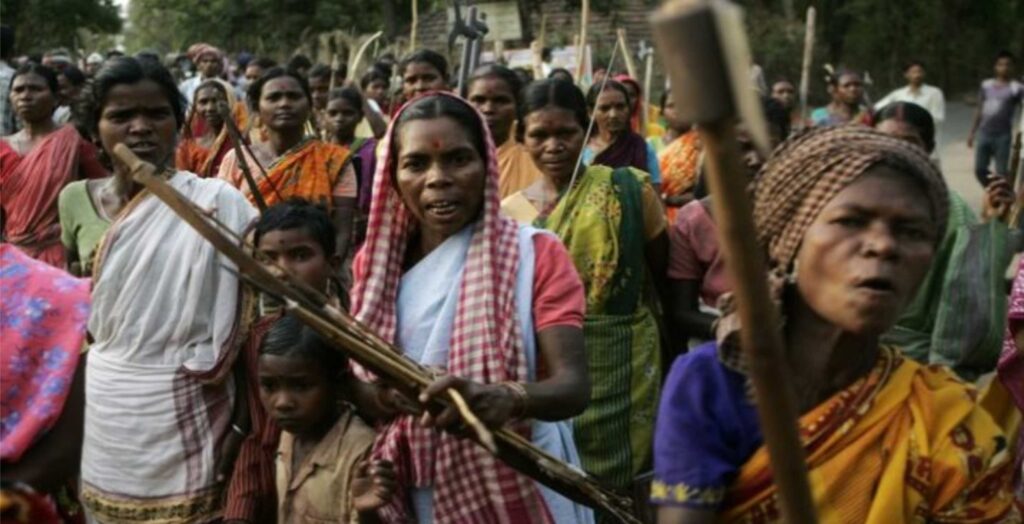Arundhati Roy skriver i en artikel från 2010 (längst ner) om maoisternas kvinnorörelse Revolutionary Adivasi Women’s Organisation (Krantikari Adivasi Mahila Sangathan) som är totalförbjuden. Här finns ett dokument från CPI(maoist):s föregångare om kvinnofrågan. Här nedan är några citat ur en artikel från 2021 som beskriver kvinnornas roll i rörelsen:
“This renewed the conversation around female Maoists composing a substantial 60% of their total cadres and occupying almost all operational and tactical positions responsible for sustaining the Maoist rebellion in India. …
Many ex-Maoist women, like Krishna Bandyopadhyay, admit Maoism’s appeal was rooted in its commitment to women’s rights. This commitment manifests in all-women squads such as the Krantikari Adivasi Mahila Sangathan (KAMS) leading extensive campaigns against forced marriage, abduction, outcasting menstruating women, bigamy, domestic violence, and police brutality. Such initiatives encourage many younger females to join the armed rebellion.”
Arundhati Roy: “This was the first women’s issue the Party decided to campaign against. It had to be handled delicately, with surgical tools. In 1986 it set up the Adivasi Mahila Sanghathana (AMS) which evolved into the Krantikari Adivasi Mahila Sangathan (KAMS) and now has 90,000 enrolled members. It could well be the largest women’s organization in the country.
(They’re all Maoists by the way, all 90,000 of them. Are they going to be ‘wiped out’? And what about the 10,000 members of CNM? Them too?) The KAMS campaigns against the adivasi traditions of forced marriage and abduction. Against the custom of making menstruating women live outside the village in a hut in the forest. Against bigamy and domestic violence. It hasn’t won all its battles, but then which feminists have? For instance, in Dandakaranya even today, women are not allowed to sow seeds. In Party meetings men agree that this is unfair and ought to be done away with. But in practice, they simply don’t allow it. So the Party decided that women would sow seeds on common lands, which belongs to the Jantana Sarkar. On that land they sow seed, grow vegetables, and build check dams. A half-victory, not a whole one.
As police repression has grown in Bastar, the women of KAMS have become a formidable force and rally in their hundreds, sometimes thousands to physically confront the police. The very fact that the KAMS exists has radically changed traditional attitudes and eased many of the traditional forms of discrimination against women. For many young women, joining the Party, in particular the PLGA, became a way of escaping the suffocation of their own society. Comrade Sushila, a senior office bearer of KAMS talks about the Salwa Judum’s rage against KAMS women. She says one of their slogans was Hum Do Bibi layenge! Layenge! (We will have two wives! We will!) A lot of the rape and bestial sexual mutilation was directed at members of the KAMS. Many young women who witnessed the savagery then joined the PLGA and now women make up 45% of its cadre. Comrade Narmada sends for some of them and they join us in a while.
Comrade Rinki has very short hair. A Bob-cut as they say in Gondi. It’s brave of her, because here, ‘bob-cut’ means ‘Maoist.’ For the police that’s more than enough evidence to warrant summary execution. Comrade Rinki’s village, Korma was attacked by the Naga Battalion and the Salwa Judum in 2005. At that time Rinki was part of the village militia. So were her friends Lukki and Sukki, who were also members of the KAMS. After burning the village, the Naga battalion caught Lukki and Sukki and one other girl, gang raped and killed them. “They raped them on the grass”, Rinki says, ” but after it was over there was no grass left.” It’s been years now, the Naga Battalion has gone, but the police still come. “They come whenever they need women, or chickens.”

